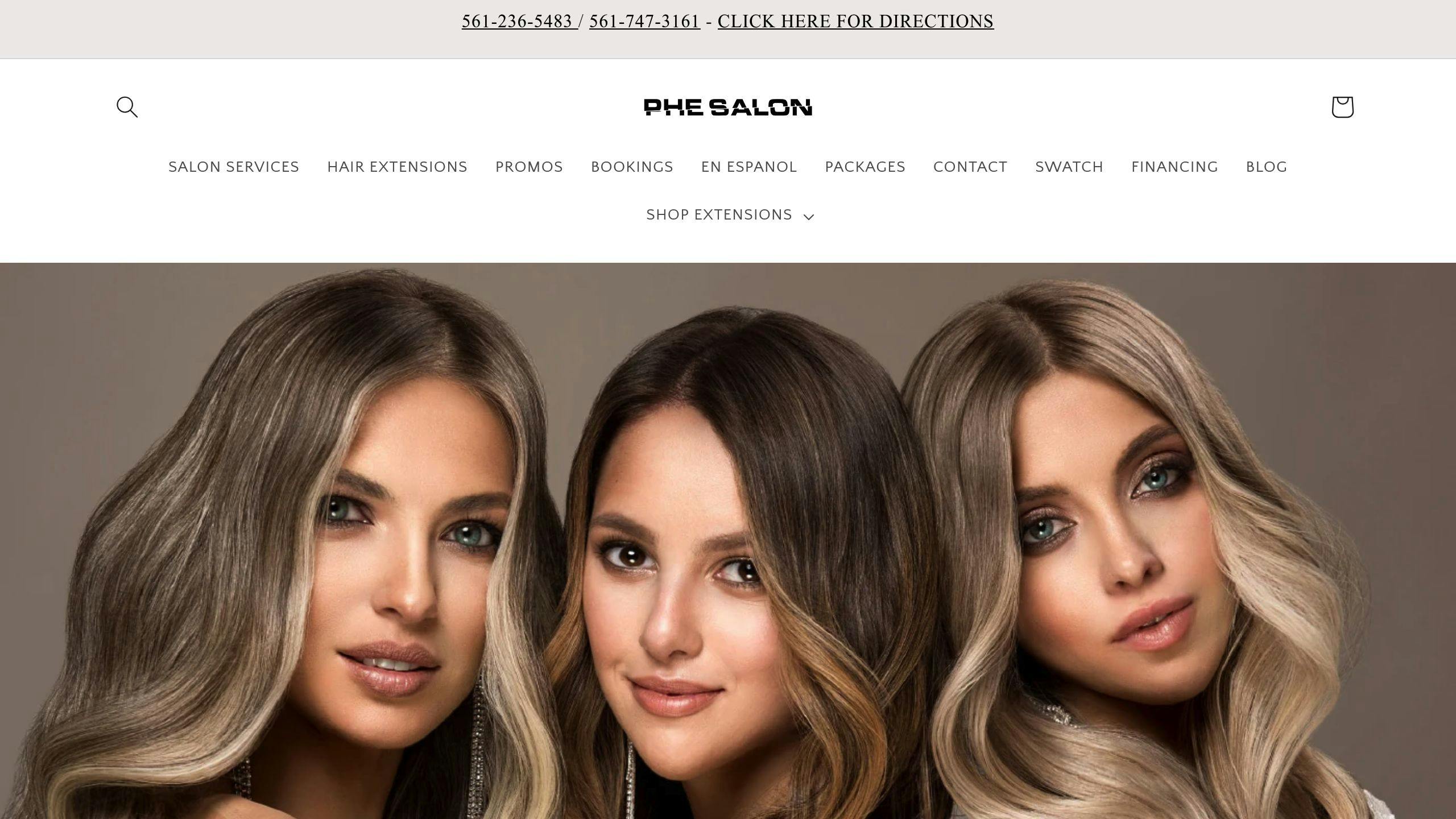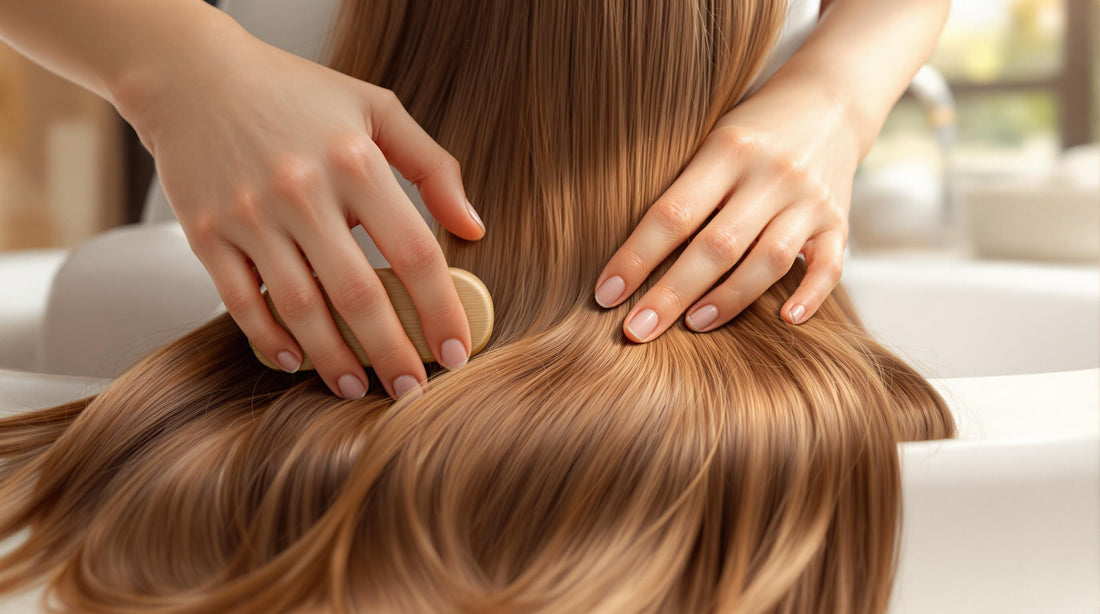Brushing hair extensions the right way is key to keeping them smooth, tangle-free, and long-lasting. Here's what you need to know:
- Use the Right Brush: Choose soft-bristle brushes, wide-tooth combs, or loop brushes depending on your extension type. Avoid tightly packed or ball-tipped bristles, which can cause damage.
- Brush Gently: Start at the ends, work upwards, and use light strokes to avoid pulling or stressing attachment points.
- Limit Brushing: Brush 2-3 times daily - morning, evening, and mid-day if needed. Overbrushing can lead to shedding or damage.
- Handle Wet Extensions Carefully: Let them air dry 80% before brushing or use a wide-tooth comb with detangling spray for damp hair.
- Protect Extensions at Night: Braid loosely, sleep on a silk pillowcase, and avoid going to bed with wet extensions.
Quick Tool Guide:
| Extension Type | Recommended Brush |
|---|---|
| Clip-ins | Wide-tooth comb |
| Tape-ins | Soft paddle brush |
| Bonded | Loop brush |
By following these tips, you can maintain your extensions' look and extend their lifespan.
How to Properly Brush Hair Extensions
How to Choose the Best Brush for Hair Extensions
Picking the right brush is crucial for keeping your extensions smooth and avoiding damage. The right tools not only make brushing easier but also help maintain the look and lifespan of your extensions.
Why Soft Bristles and Wide-Tooth Combs Are Ideal
Soft bristles and wide-tooth combs are gentle on extensions, reducing the risk of pulling or damaging both your natural hair and the attachment points. Brushes with soft nylon or boar bristles [1] are especially effective because they:
- Protect attachment points by minimizing tension
- Detangle without causing snags
- Keep extensions aligned and smooth
Each type of extension benefits from a specific brush. For example, wide-tooth combs work well for clip-ins, loop brushes (designed with looped bristles to avoid catching on bonds) are great for bonded extensions, and soft paddle brushes are perfect for tape-ins.
| Extension Type | Recommended Brush Type |
|---|---|
| Clip-in | Wide-tooth comb or flat paddle brush |
| Bonded | Loop brush |
| Tape-in | Soft bristle paddle brush |
Brushes to Avoid for Hair Extensions
Stay away from brushes with tightly packed or ball-tipped bristles. These can snag and damage your extensions, leading to matting and breakage [4]. Using the wrong brush can drastically shorten the life of your extensions.
Now that you know which brushes to use, it's time to learn the best brushing techniques to keep your extensions looking their best.
Steps to Brush Hair Extensions Without Causing Damage
Start Brushing at the Ends First
To avoid tangling, hold your extensions at mid-length and begin brushing the ends first. This prevents knots from tightening and reduces strain on the attachment points.
Use Gentle Strokes While Brushing
Always brush with light, controlled strokes to avoid unnecessary tension. Hold each section of hair 2-3 inches above the area you're brushing to avoid pulling at the roots. Pay special attention near the attachment points, as too much force can loosen the bonds or tape.
| Area | Technique |
|---|---|
| Ends | Short, gentle strokes |
| Mid-length | Light, smooth movements |
| Root area | Minimal contact near bonds |
While proper technique is important, brushing too often can also damage your extensions.
Limit How Often You Brush
Stick to brushing your extensions 2-3 times a day - morning, mid-day if needed, and evening. This routine helps keep them tangle-free without overworking the hair. Watch for signs of overbrushing, like unusual shedding or frequent tangling [1].
How to Handle Wet Hair Extensions
Before brushing wet extensions, let them air dry until they are about 80% dry [2]. If you need to detangle while they're still damp, use a wide-tooth comb and a detangling spray. Start at the ends and work upward, supporting each section as you go to avoid stressing the attachments.
Brushing Tips for Different Types of Hair Extensions
Using the right tools and techniques is essential for keeping your extensions in great shape. The brushing method you use should match the type of extensions you have to avoid damage and help them last longer.
Brushing Permanent Extensions (Fusion, Tape-In, Sew-In)
Permanent extensions need special care to protect their attachment points:
- Fusion Extensions: Hold the hair firmly about 2–3 inches above the bonds. Use a loop brush to detangle gently, avoiding direct contact with the fusion points. Keep the brush aligned with the hair shaft to prevent snagging.
- Tape-In Extensions: Steer clear of brushing directly over the tape tabs. Instead, support the hair near the tape and use a soft-bristle brush to detangle. Work in small sections to maintain control and avoid pulling on the attachments.
- Sew-In Extensions: Focus on the mid-lengths and ends with a wide-tooth comb. Be extra gentle around the sewn wefts to prevent loosening. Always support the section you're brushing to reduce tension on the tracks.
Brushing Temporary Extensions (Clip-In, Halo, Ponytail)
Temporary extensions are easier to manage since they can be brushed while off your head. For clip-ins, halo, and ponytail extensions, brush them before and after use to keep them smooth and tangle-free. Lay them flat on a clean surface for better control, and use gentle, even strokes.
Tips for Temporary Extensions:
- Brush before applying to ensure a smooth installation.
- Detangle after removing to prevent matting.
- Make sure the extensions are completely dry before storing to avoid mildew.
- Store them in a silk or satin bag to maintain their condition. [1][5]
Following these brushing and storage practices will keep your extensions looking their best and ready for the next wear.
sbb-itb-4220d4e
Extra Tips for Keeping Hair Extensions in Good Condition
Taking care of hair extensions requires consistent effort and attention. Beyond brushing, there are a few key habits that can help maintain their look and longevity.
Daily Brushing Habits for Hair Extensions
Brushing daily is key to keeping extensions smooth and free of tangles. A detangling spray can make the process easier and help protect the hair [1]. Pair this with the right brush for the best results.
| Time of Day | Brushing Action | Purpose |
|---|---|---|
| Morning | Gentle detangling | Smooth out overnight knots |
| Mid-day | Quick touch-up | Avoid tangles during the day |
| Evening | Thorough brushing | Prep for nighttime care |
While brushing is important, what you do before bed also plays a big role in keeping your extensions in good shape.
How to Protect Hair Extensions While Sleeping
Taking the right steps before sleeping helps maintain the quality of your extensions.
Key nighttime tips:
- Braid your hair loosely and secure it with a soft tie to avoid stressing the bonds or tapes.
- Make sure your extensions are completely dry before heading to bed.
- Sleep on a silk or satin pillowcase to minimize friction.
- Avoid going to sleep with wet extensions, as this can lead to matting [1][5].
If you have permanent extensions, be extra careful around the attachment points. If you encounter tangles while brushing, don’t force it - use a light detangling spray and gently work through the knots starting at the ends.
Professional Hair Extension Services at PHE Salon Jupiter Florida

Taking care of hair extensions requires expert advice, and PHE Salon in Jupiter, Florida is here to help. They specialize in delivering top-notch services to ensure your extensions look stunning and last longer.
Hair Extension Options at PHE Salon
At PHE Salon, you’ll find a range of premium extension options made from high-quality human organic and Remy hair. Popular choices include:
| Extension Type | Benefits |
|---|---|
| Keratin Tips | Blend naturally with your hair |
| Hand-tied Wefts | Lightweight and comfortable to wear |
Every service is tailored to fit your hair type, lifestyle, and preferences, making maintenance simpler and results more satisfying.
Complimentary Consultations at PHE Salon
Not sure which extensions are right for you? PHE Salon offers free consultations to guide you. During these sessions, their experienced stylists provide:
- Personalized advice based on your hair type and daily routine
- Detailed explanations of extension options and care tips
- Customized solutions designed to meet your specific needs
Their team ensures you leave with all the information you need to keep your extensions looking their best. By teaching proper care techniques, they help you avoid common pitfalls and maximize the lifespan of your extensions.
With PHE Salon’s expert support, maintaining gorgeous, healthy extensions becomes a seamless part of your routine.
Conclusion: Key Points for Brushing Hair Extensions Safely
Taking care of your hair extensions with the right brushing techniques helps maintain their look and longevity. Using tools like wide-tooth combs and soft-bristle brushes is ideal for gentle detangling while keeping attachment points secure.
Brush your extensions twice a day - once in the morning and again in the evening. Use soft, careful strokes to keep them tangle-free without stressing the hair. Always let your extensions air dry before brushing. If you need to detangle damp hair, use a wide-tooth comb along with a detangling spray applied gently [1][2].
Different types of extensions require slightly different care:
- Permanent extensions (fusion, tape-in): Be cautious around the attachment points.
- Temporary extensions: Brush them only when they’re removed from your hair [1].
Here are a few extra tips to get the best results:
- Hold the hair securely while brushing to avoid unnecessary tension.
- Start brushing from the ends and work your way up to the roots.
- Use detangling products as needed.
- Always follow the care instructions provided by the manufacturer.
For personalized advice, consider consulting a professional stylist who can recommend the best care methods for your specific extensions and lifestyle. Following these steps will help keep your extensions in great shape. For more tips and answers to common questions, check out the FAQs below.
FAQs
Here are answers to some common questions about brushing hair extensions to help you take care of them properly.
What type of brush should you use for hair extensions?
The best options are a boar bristle brush or a brush specifically designed for hair extensions. These brushes have soft, flexible bristles that detangle gently, avoiding damage to the attachment points. For wet extensions, a wide-tooth comb works well for detangling [1][6].
How do you brush matted hair extensions?
Start by lightly misting the extensions with a conditioning spray to make them easier to manage. Hold the hair near the roots to protect the attachment points, then use a detangling brush to work through the tangles, starting at the ends and moving upward. Take your time to avoid causing more tangles or damage [2][3].
Is it possible to overbrush hair extensions?
Yes, brushing too much can harm your extensions. Brush only when needed, focusing on detangling or smoothing. Overbrushing can lead to shedding or resistance while brushing. Use light pressure and let the brush glide naturally through the hair [1][2].
| Time of Day | Purpose | Technique |
|---|---|---|
| Morning | Remove tangles from sleep | Start at the ends, work to roots |
| After washing | Prevent matting | Use wide-tooth comb on damp hair |
| Before bed | Avoid overnight tangles | Light brushing, secure for sleep |

